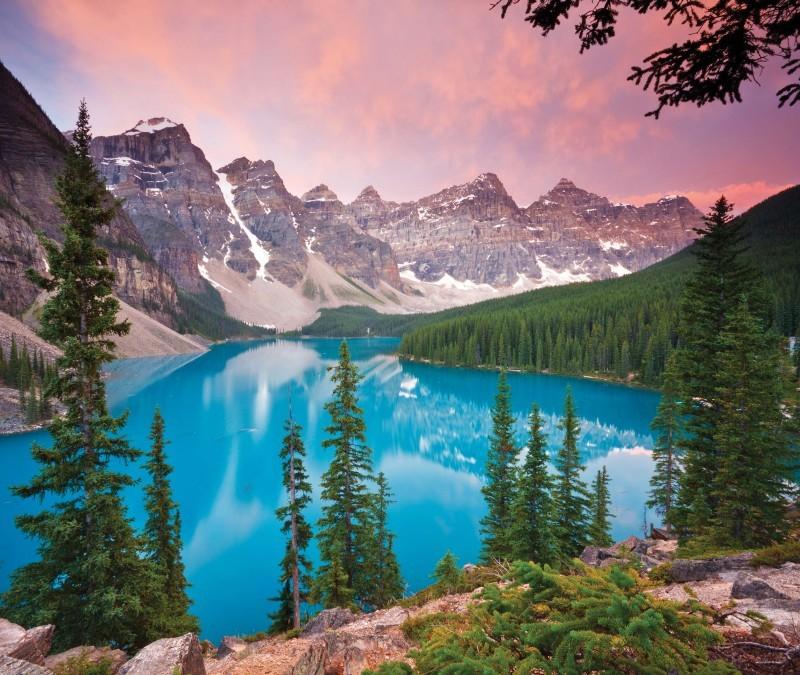Kruzic: Proposed tar sands pipeline a deadly idea
Beautiful Dawn at Moraine Lake.
September 7, 2011
As of lately, there has been an immense amount of controversy surrounding the proposed Keystone X.L. pipeline. More than 1,200 environmental activists have been arrested at protests, politicians of both parties have voiced their opposition, economists have argued their support of the plan, scientists have argued against it and celebrities and citizens have joined the heated conversation.
The proposed project, a 1,700-mile pipeline, would run from Alberta in western Canada and go through the states of Montana, South Dakota, Nebraska, Kansas, Oklahoma and Texas. The purpose of the pipeline is to carry crude petroleum known as bitumen from one of the largest oil reserves in the world to refineries in Texas.
Though deemed economically necessary and useful by many, the project has galvanized an ever-growing opposition movement. Many argue the risks greatly outweigh whatever positive economic impact the pipeline could offer the country. Activists, politicians, climate scientists and citizens fear the pipeline’s impact on greenhouse gas emissions, potential for spill disasters and the destruction of terrestrial ecosystems — and rightfully so.
Everything else aside, oil extraction from tar sands is arguably the dirtiest energy production method available. The sole construction of the pipeline and recovering of tar sands in Alberta will directly devastate and ruin an area of land the size of the entire country of England. Canada’s Boreal Forest, one of the last remaining pristine forests on the planet, is being strip-mined to access the tar sands, effectively destroying it acre by acre; the industry even admits the damage is irreversible.
Because the oil is stuck in tar sands, it must be mined out of the ground, squeezed and boiled — using more water than a city with a population of 2 million people. The water must be heated with another fossil fuel — natural gas. In 2007 alone, the tar sands used 1 billion cubic feet of natural gas per day — with much of it obtained via fracking. Wastewater as a result of the process is stored in toxic ponds so large they can be seen from outer space; 11 million liters of wastewater is leaked into groundwater and other sources each day.
In addition to the inevitable destruction of life in the pipeline construction process, the possibility of a terrestrial BP-style oil spill post-construction in the states of Montana, South Dakota, Nebraska, Kansas, Oklahoma and/or Texas is a very real threat.
How forgetful are we? Disasters, destruction and loss of life as a result of dirty oil are rampant. The Deepwater Horizon oil spill, also known as the BP spill, impacted 16,000 miles of coastline just one year ago. The ecosystems, economy and life along the coastlines of Texas, Louisiana, Mississippi, Alabama and Florida have been forever scarred. Today, oil still washes up on the shores. Long-term effects of the 17 to 39 billion gallons spilled are uncertain, but science and common sense tells us it won’t be good.
On July 1, just more than two months ago, an Exxon pipeline dumped 54,000 gallons of oil into the beautiful Yellowstone River. Oil has spread as far away as 240 miles from the spill. Contamination was found on approximately 60 percent of shoreline inspected downstream from the pipeline break. Livestock had to be relocated, local farmers’ crops were lost, water quality was diminished and serious concern for the long-term health of surrounding ecosystems has been raised.
The precursor pipeline to the Keystone X.L., a much smaller pipeline and pumping station system, has leaked 12 times in its first year of operation. That’s right, 12. As if that’s not scary enough, this particular proposed pipeline will be run over the Ogallala aquifer, the largest source of freshwater located in the middle of the continent.
The aquifer, being one of the world’s biggest, covers an area of around 174,000 square miles and sits beneath portions of South Dakota, Nebraska, Wyoming, Colorado, Kansas, Oklahoma, New Mexico and Texas; its volume is estimated at more than 1 million billion gallons of water, or 1 quadrillion. The aquifer provides drinking water for 82 percent of people who live within the aquifer boundary, and about 30 percent of the groundwater used for irrigation of U.S. farmland is pumped from the aquifer.
Everyone is impacted: the farmers, the livestock, the crops, the people who consume the products, the residents, the communities and the nation. The planet simply cannot afford to lose a resource of this caliber to yet another oil-saturated bath.
NASA climatologist Jim Hansen warns that to save our planet from destruction, something must be done: “… The principal requirement is that coal emissions must be phased out by 2030 and unconventional fossil fuels, such as tar sands, must be left in the ground.” He continued to explain that “… if the tar sands are thrown into the mix it is essentially game over for the climate.”
Politics aside, the proposed pipeline is quite literally deadly. Jeremiah 2:7 describes our current relationship with the environment best: “I brought you into a fertile land to eat its fruit and rich produce. But you came and defiled my land and made my inheritance detestable.”

















